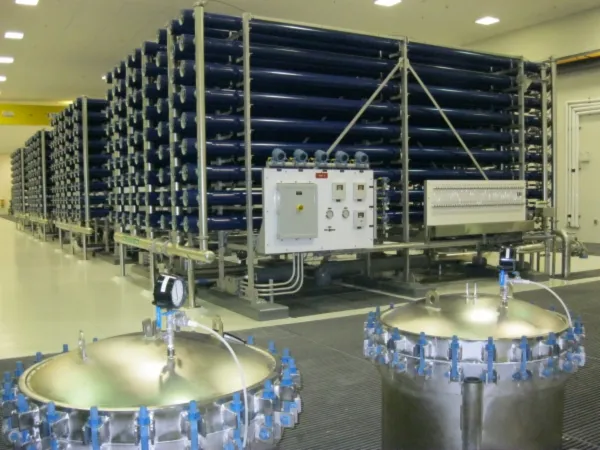Reverse osmosis (RO): What Is It and How Does It Work?
The method is mostly used in the production of drinking water when the raw water is extremely salty, particularly sea water (salinity of 30 g/l), and groundwater (salinity ranging from 1.5 to 3 g/l). Therefore, when monovalent electrolytes are present in significant concentrations, RO filtration system is required, so this process is able to remove various contaminants from the water, including radioactive elements, arsenic, boron, nitrates, and nitrites, as well as pesticides.

Cutaway of a 16" reverse osmosis tube
Due to the helical nature of the membranes employed in this system, a pre-treatment step including filtering with the (UF) system in the range of 1 to 25 microns must be completed before the RO stage. The reverse osmosis water treatment plant should also have a method for chemically adjusting the media's pH, alkalinity, and hardness. The performance of reverse osmosis membranes in eliminating mineral and biological contaminants from treated water is shown in Table 2, provided that excellent initial filtering is ensured and the reverse osmosis treatment procedure is carried out under completely regulated circumstances to avoid the membrane from becoming an ideal environment for microorganism growth.

[Made using Microsoft Word]
A treatment plant using a reverse osmosis unit contains the following:
Raw water tank, sand filter, activated charcoal filter, membrane filter, high pressure pump, membranes, reverse osmosis system.

the North Cape Coral RO facility
In addition, some chemicals must be available in the four types of membrane filtration treatment units. These chemicals are:
- Anti-scale agent (added to the incoming raw water).
- Acid solutions.
- Sterilizers.
- Alkaline solutions.
- Enzymes.
References:
- [Introduction to Water Chemistry (Pollution- Treatment- Analysis). Dr. Nasser Al-Hayek. Publication of the Higher Institute for Applied Sciences and Technology (HIAST). Syrian Arab Republic, 2017.]
- Taparhudee, Wara (2002). "Applications of Paddle Wheel Aerators and Diffused-Air System in Closed Cycle Shrimp Farm System" (PDF). Witthayasan Kasetsart (Sakha Witthayasat). 36: 408–419. Retrieved 26 April 2020.
- Unsafe water kills more people than war, Ban says on World Day". UN News. 22 March 2010. Retrieved 10 May 2018
- Raymond Desjardins- Livre: Le traitement des eaux- 2éme edition- Ecole Polytechnique de Montréal- 1997- ISBN 2-553-00643-8
- Drinking Water Treatment- EDX- Delft University of Technology.
- Book- Drinking Water: Principles and Practices- by Hans J C Van Dijk (Author), Jasper Q J C Verberk (Author), Peter J De Moel.